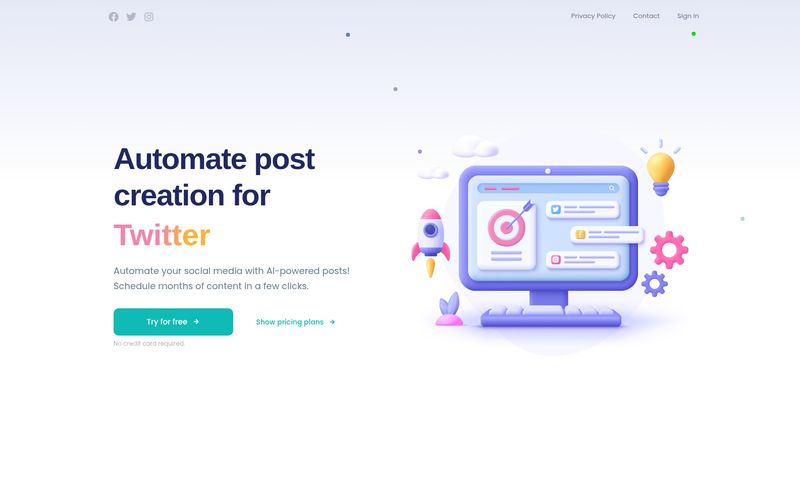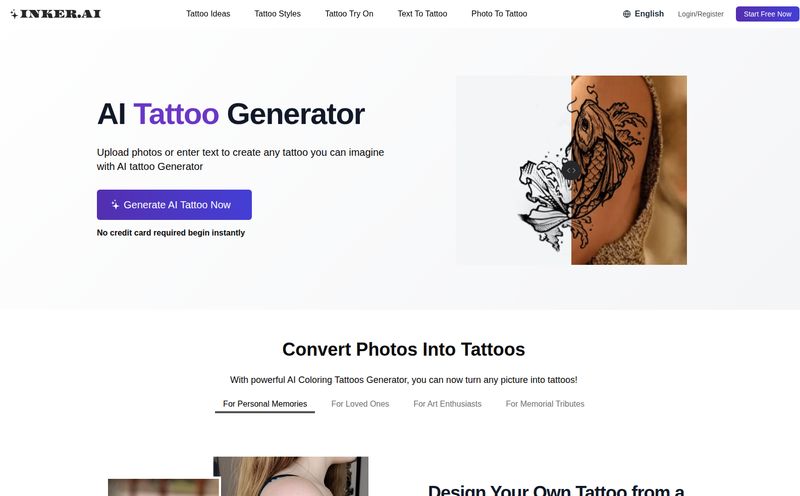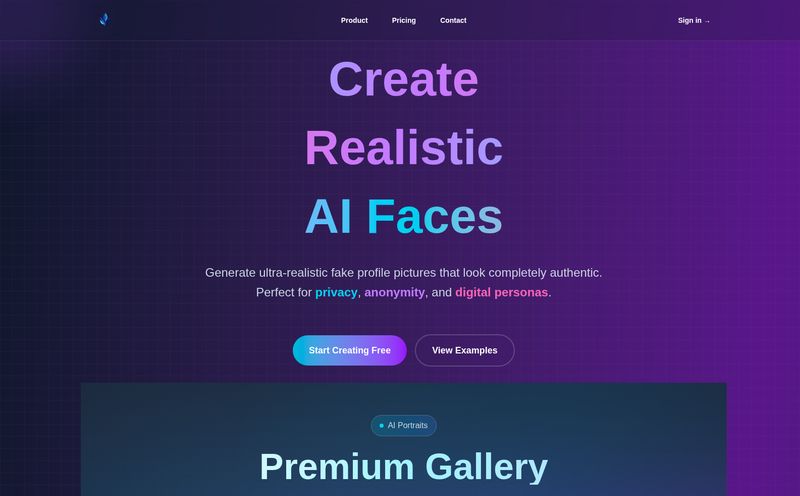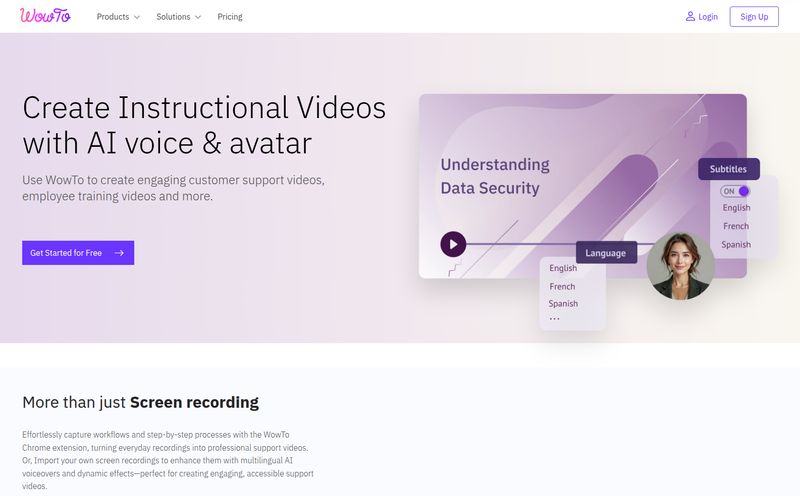I’ve spent more late nights than I care to admit waiting for a render to finish. You know the feeling. Staring at a progress bar, praying your computer doesn’t crash, all for a single image that the client might glance at for five seconds before saying, “Can we see it in a different color?” It’s the glamorous life of a designer, right?
For years, that was just the cost of doing business. But the ground is shifting. Fast. AI tools are popping up everywhere, and the design world is no exception. Some folks are nervous, others are excited. Me? I’m just curious. I want to know if these new toys can actually make my life easier. That's what led me to mnml.ai, an AI design assistant built specifically for architects and interior designers.
So, I signed up, burned through some credits, and I’m here to give you the real scoop. No marketing fluff, just my honest take as someone who lives and breathes this stuff.
What Exactly Is mnml.ai?
Think of mnml.ai as a super-fast junior designer who never needs to sleep or drink coffee. It’s an AI platform that takes your designs—whether they're simple sketches, basic 3D models from SketchUp, or existing renders—and reimagines them in seconds. We’re talking new styles, different materials, photorealistic lighting, the whole nine yards.
Its main job is to crush the time it takes to visualize and iterate. Instead of spending hours or days tweaking a model for a few different looks, you can generate a dozen variations before your coffee gets cold. It's all about speed and creative exploration.
The Core Features That Actually Matter
A lot of these AI platforms throw a million features at you. It can be overwhelming. With mnml.ai, I found myself coming back to a few key functions that fit right into a typical design workflow.
From Napkin Sketch to Photorealistic Concept
This is where the magic really starts. The Sketch to Image tool is pretty wild. I uploaded a very, very rough sketch of a cabin—I’m talking messy lines, barely a concept—and it turned it into a surprisingly coherent architectural render. It's not going to produce final construction drawings, obviously, but for getting an idea out of your head and into a visual format? It’s incredible.
Then you have the Render Enhancer. If you have a basic, flat-looking render from another program, you can run it through this to add realistic lighting, textures, and atmosphere. It’s a quick way to breathe life into a sterile image.
The Endless “What If” Machine
This is my favorite part. The Redesign, Interior AI, and Exterior AI tools are built for iteration. You upload your design and just start playing. “What if this modern home was rustic?” Bam. Done. “Show me this living room with a Japandi style.” Click. There it is. You can change materials, add furniture, and alter the mood with a simple text prompt.
“This ability to generate options instantly doesn’t just save time; it changes the conversation with clients. You can explore ideas live with them, making the design process more collaborative and frankly, more fun.”
No more going back to the drawing board for a week to show a different cladding option. The sheer speed is the selling point here.
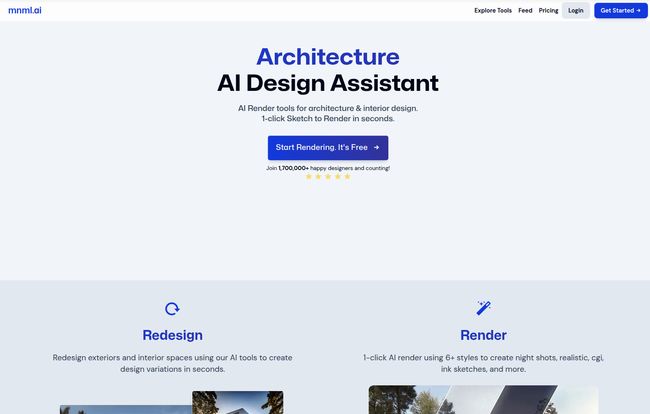
Visit mnml.ai
Beyond Static Images
mnml.ai isn't just for still images. The AI Video Maker can create short fly-throughs or animations from your renders, which is a huge value-add for client presentations. They also have tools like Style Transfer Render (imagine applying Van Gogh’s style to a building render) and a text-to-image generator called Imagine, which is great for pure blue-sky ideation when you're stuck for a concept.
My Honest Take on Using mnml.ai
Okay, so it sounds great on paper. But how does it feel to actually use? It's a bit of a mixed bag, but mostly positive.
Where It Shines Brightest
The speed is, without a doubt, its biggest strength. For conceptual design and early-stage presentations, it’s a game-changer. I also love how intuitive the interface is. Unlike the steep learning curve of some 3D modeling software, you can get meaningful results from mnml.ai within minutes. It's not trying to replace your CAD or BIM software; it's designed to be a helpful sidekick, and it plays that role perfectly.
Some Things to Keep in Mind
It's not perfect, of course. The quality of the output is heavily dependent on the quality of your input. A vague prompt or a messy base image will give you a vague or messy result. It’s a tool, not a mind reader. You still need a designer’s eye to guide it.
Also, and this is important for professionals, commercial use is only allowed on the paid plans. The free credits you get for signing up are for testing the waters, not for client work. And you do have to watch your credits. Each render or video costs a certain amount, so you can burn through them quickly if you're not careful. It makes you a bit more deliberate with your generations.
A Look at the mnml.ai Pricing Structure
So, what's this going to cost you? The pricing is subscription-based, using a credit system. They have a few tiers, plus a one-time credit pack if you don't want to commit.
Here’s a simplified breakdown:
| Plan | Monthly Price | Key Features |
|---|---|---|
| Basic Plan | $19 | 1,000 Credits, 100 Designs, Commercial Use |
| Pro Plan | $39 | 5,000 Credits, 500 Designs, Commercial Use |
| Expert Plan | $79 | 10,000 Credits, 1,000 Designs, Commercial Use |
Note: Prices are lower if you opt for yearly billing. As of this writing, they also had a New Year's promo code (HELLO28) for a discount, so keep an eye out for deals.
My take? The Pro Plan seems like the sweet spot for most freelancers and small studios. The Basic plan's credits might feel a little tight if you're using it regularly. For anyone just wanting to try it on a single project, the One-Time Credit Pack for $49 is a pretty good option without the monthly commitment.
Who Should Really Use This Tool?
So, is mnml.ai for you? I think it’s a fantastic fit for a few groups:
- Students & Educators: An amazing, low-cost way to visualize ideas without spending hundreds of hours learning complex rendering engines. They even have an education discount.
- Solo Architects & Freelance Designers: This could be your secret weapon. It allows you to produce the quantity and quality of visualizations that once required a whole team.
- Small to Medium Design Firms: It's a major productivity booster. It frees up your skilled designers from the monotonous task of creating render variations so they can focus on, you know, actual design.
If you're a massive enterprise with a deeply embedded, custom software pipeline, this might not replace your current system. But even then, for quick concept work? I’d say it’s worth a look.
Frequently Asked Questions
- Can I use mnml.ai for commercial projects?
- Yes, you absolutely can, but you must be on one of the paid subscription plans (Basic, Pro, or Expert) or have purchased a credit pack. The initial free credits are for personal trial and experimentation only.
- What happens if I run out of credits during the month?
- If your credits run out, you'll need to either upgrade your plan to the next tier or purchase a one-time credit pack to continue generating designs until your monthly subscription renews.
- Is mnml.ai difficult for beginners to learn?
- Not at all. In my experience, it's one of the more intuitive AI design tools out there. The interface is clean, and the process of uploading an image and applying a style or prompt is very straightforward. You don't need to be an expert in prompting or 3D software.
- How does the AI handle very specific or technical details?
- It's best to think of mnml.ai as a tool for conceptualization, mood boarding, and stylistic exploration. It's brilliant for that. For highly technical, dimension-perfect construction details, you'll still rely on your primary CAD or BIM software. The AI is an artist, not an engineer.
- Is there a free trial so I can test it?
- Yes, when you sign up for an account, you get a handful of free credits to try out the platform's features. It's enough to get a good feel for how it works before you decide to subscribe.
So, Is mnml.ai Worth It?
After spending some real time with it, my answer is a solid yes. But with a condition. It's worth it if you understand what it is: a powerful assistant, not a replacement for a designer.
It won't solve a bad design, but it will help you find the best version of a good design much, much faster. It takes the tedious, time-consuming part of visualization and puts it on autopilot, freeing you up to do what you do best—create.
For me, any tool that buys back hours of my life and helps me better communicate a vision to a client isn’t just a novelty; it’s an essential part of the modern toolkit. And mnml.ai has certainly earned its place in mine.
